|
Have a safe day!
Thursday, April 5
2:30 p.m.
Theoretical Physics Seminar - Curia II
Speaker: Chuan-Ren Chen, Argonne National Laboratory
Title: Top Quark Forward-Backward Asymmetry and New Physics
3:30
DIRECTOR'S COFFEE BREAK -
2nd Flr X-Over
THERE WILL BE NO ACCELERATOR PHYSICS AND TECHNOLOGY
SEMINAR TODAY
Friday, April 6
3:30 p.m.
DIRECTOR'S COFFEE BREAK - 2nd Flr X-Over
4 p.m.
Joint Experiment-Theoretical Physics Seminar - One West
Speaker: Brendan Kiburg, University of Washington
Title: Muon Capture on the Proton: Final Results from the MuCap Experiment
Click here for NALCAL,
a weekly calendar with links to additional information.
Upcoming conferences |
|
Thursday, April 5
- Breakfast: Apple sticks
- Tomato Florentine
- BBQ pork sandwich
- Smart cuisine: Kielbasa & sauerkraut
- Smart cuisine: Chicken marsala
- Smoked turkey melt
- Assorted sliced pizza
- SW chicken salad w/ roasted corn salsa
Wilson Hall Cafe Menu
|
|
Friday, April 6
Dinner
Closed
Wednesday, April 11
- Salmon w/ sweet chili sauce
- Sugar snap peas
- Coconut rice
- Pineapple flan
Chez Leon Menu
Call x3524 to make your reservation.
|
|
Brainstorming to save money
Bruce Chrisman, Fermilab's chief operating officer, wrote this column.
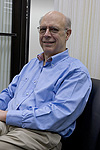 |
|
Bruce Chrisman |
With the recent laboratory cutbacks and the ongoing economic situation, we are all brainstorming ways to save money. As such, I will address two ideas that several employees have brought to our attention.
The first is a shuttle for Fermilab employees and users to and from the train station. This is an appealing prospect, especially with the soaring price of gas, but Fermilab's contract with DOE does not allow for the cost of commuting for employees or users.
The other suggestion we've heard frequently is the possibility of moving to a four-day workweek, with employees working four ten-hour days instead of five eight-hour days. In the past, we've analyzed this idea with little headway. Fermilab is a 24 hours a day, seven days a week facility. In order to have enough personnel for necessary safe operations, we cannot parse down the number of days in the workweek across the board. For example, it would be nearly impossible for management and supervisors to schedule meetings within each division, section and center.
We are actively investigating other cost-saving measures. I encourage you to speak up if you have an idea that could make the laboratory more efficient or that could ease difficulties for your colleagues.
|
Fermilab scientist emeriti
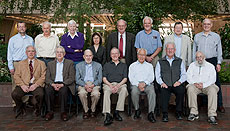 |
| From bottom left, counterclockwise: Chuck Schmidt, Moyses Kuchnir, Joe Lach, Alan Wehmann, Lee Teng, Chuck Brown, Norman Gelfand, Bruce Chrisman, John Yoh, Hans Jostlein, Bill Bardeen. Also in attendance to honor the scientists emeriti were Young-Kee Kim, Alvin Tollestrup, Roy Rubinstein, Greg Bock Photo: Reidar Hahn |
The 2011 Fermilab scientist emeriti gathered for lunch and a picture on March 16. The status of scientist emeritus is granted in the recognition of the scientist's contributions to the laboratory over his or her career. They are all invited to continue scientific connections with the laboratory, and they each belong to a division or center and may receive Fermilab resources as appropriate.
To initiate the appointment process, scientists must discuss emeritus status with their division or section head, who may then recommend the status to the Directorate. The Directorate may then recommend the appointment to the FRA Board of Directors, summarizing the candidate's career accomplishments and major contributions to the laboratory.
To see the full list of Fermilab scientists honored as scientist emeriti, please click here.
|
Physicists hunt for dark forces
From Nature, April 3, 2012
In tunnels beneath the Thomas Jefferson National Accelerator Facility in Newport News, Virginia, an accelerator whips a beam of electrons around a racetrack. Their energies are modest, but the beam is tightly packed with them — for it takes a very bright beam to detect a photon that doesn't shine.
In a three-week experiment due to start on 24 April, the electrons will crash into a thin tungsten target at 500 million times a second, creating a cascade of short-lived particles. Amid the debris, physicists with the Heavy Photon Search (HPS) are hoping that they will find signs of something exceedingly rare: a 'heavy' or 'dark' photon. The discovery would open the door to an unseen world of dark forces and dark atoms that theorists have long speculated about — and could help to pin down the dark matter that is thought to comprise 85% of the matter in the Universe.
The HPS researchers at the Jefferson Lab are quick to concede that the experiment, like two others at the lab probing this dark sector, is a long shot that is likely to achieve little more than null results. But the reasonable price tags for such projects — about US$3 million to build and run the HPS detector — have prompted more physicists to try. "It's always a great question in physics to go around wondering if there are more fundamental forces," says physicist John Jaros, co-spokesman for the HPS experiment.
Read more
|
Kepler Mission extended to 2016
From PhysOrg.com, April 4, 2012
With NASA's tight budget, there were concerns that some of the agency's most successful astrophysics missions might not be able to continue. Anxieties were rampant about one mission in particular, the very fruitful exoplanet-hunting Kepler mission, as several years of observations are required in order for Kepler to confirm a repeated orbit as a planet transits its star. But today, after a long awaited Senior Review of nine astrophysics missions, surprisingly all have received funding to continue at least through 2014, with several mission extensions, including Kepler.
"Ad Astra… Kepler mission extended through FY16! We are grateful & ecstatic!" the @NASAKepler Twitter account posted today.
Additionally, missions such as Hubble, Fermi and Swift will receive continued funding. The only mission that took a hit was the Spitzer infrared telescope, which – as of now — will be closed out in 2015, which is sooner than requested.
Read more
|
|
DZero confirms newly observed particle
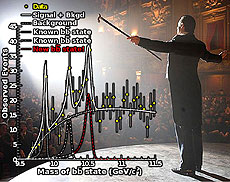 |
| A magician's feats are not meant to be repeatable, but the reproducibility of results, such as this confirmation of a newly observed particle, is key to the scientific process.
|
When a magician produces a rabbit out of an empty hat during a performance, you don't expect to go home and repeat the feat yourself. When a scientist claims to see something new, the expectation is that the observation can be repeated. Reproducibility is a key aspect of scientific inquiry and motivates having independent but complementary experiments that can verify each other's results. The DZero and CDF experiments perform complimentary studies of the Tevatron data while ATLAS and CMS play those roles at the LHC. Independent verification is not limited to data taken from the same particle collider, though, as demonstrated by a new DZero result that has verified an exciting recent result from ATLAS.
In the Standard Model, the strong force binds quarks by twos or by threes into particles called mesons and baryons, respectively. Most of these particles are short lived, but can be identified by their mass and the type and behavior of their decay products. Recently the ATLAS collaboration observed a new particle that they interpret as an excited state of bottomonium, or a bottom and anti-bottom quark pair.
To verify this new particle, DZero analyzers started by looking for events containing a lower energy state of bottomonium that had decayed into a pair of muons. Next they looked for a photon, a sign of an excited state of bottomonium dropping down to a lower energy state. A precise energy measurement of this low-energy photon is critical to resolving the mass of the excited bottomonium states and verifying the new particle. To improve the energy measurement of these low-energy photons, the analyzers looked for photons that converted into electron-positron pairs inside of the DZero tracking system. This lets the tracking system determine the photon energy measurement, yielding the best resolution at this low energy.
The DZero experimenters verified the observation of a particle with a mass consistent with that reported by the ATLAS collaboration. Further analysis is underway to determine if this new particle is an excited state of bottomonium or perhaps something more exotic.
—Mike Cooke
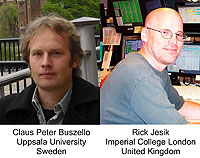 |
| These physicists made major contributions to this analysis.
|
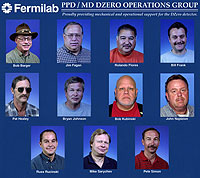 |
| The DZero mechanical crew facilitated efficient operation of the DZero detector around the clock throughout the Tevatron run and provided essential support for detector and infrastructure maintenance and upgrades. The impressive reliable operation of the infrastructure that supported the DZero experiment is a testament to the dedication and effectiveness of this team.
|
|
|